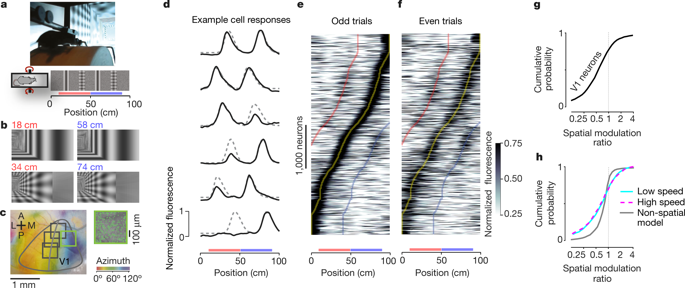Our official English website, www.x-mol.net, welcomes your
feedback! (Note: you will need to create a separate account there.)
Coherent encoding of subjective spatial position in visual cortex and hippocampus
Nature ( IF 50.5 ) Pub Date : 2018-09-10 , DOI: 10.1038/s41586-018-0516-1 Aman B Saleem 1, 2 , E Mika Diamanti 1, 3 , Julien Fournier 1 , Kenneth D Harris 4 , Matteo Carandini 1
Nature ( IF 50.5 ) Pub Date : 2018-09-10 , DOI: 10.1038/s41586-018-0516-1 Aman B Saleem 1, 2 , E Mika Diamanti 1, 3 , Julien Fournier 1 , Kenneth D Harris 4 , Matteo Carandini 1
Affiliation

|
A major role of vision is to guide navigation, and navigation is strongly driven by vision1–4. Indeed, the brain’s visual and navigational systems are known to interact5,6, and signals related to position in the environment have been suggested to appear as early as in the visual cortex6,7. Here, to establish the nature of these signals, we recorded in the primary visual cortex (V1) and hippocampal area CA1 while mice traversed a corridor in virtual reality. The corridor contained identical visual landmarks in two positions, so that a purely visual neuron would respond similarly at those positions. Most V1 neurons, however, responded solely or more strongly to the landmarks in one position rather than the other. This modulation of visual responses by spatial location was not explained by factors such as running speed. To assess whether the modulation is related to navigational signals and to the animal’s subjective estimate of position, we trained the mice to lick for a water reward upon reaching a reward zone in the corridor. Neuronal populations in both CA1 and V1 encoded the animal’s position along the corridor, and the errors in their representations were correlated. Moreover, both representations reflected the animal’s subjective estimate of position, inferred from the animal’s licks, better than its actual position. When animals licked in a given location—whether correctly or incorrectly—neural populations in both V1 and CA1 placed the animal in the reward zone. We conclude that visual responses in V1 are controlled by navigational signals, which are coherent with those encoded in hippocampus and reflect the animal’s subjective position. The presence of such navigational signals as early as a primary sensory area suggests that they permeate sensory processing in the cortex.When running through a virtual reality corridor, a mouse’s position is represented in both the hippocampus (as expected) and the primary visual cortex, for places that are visually identical.
中文翻译:

视觉皮层和海马主观空间位置的相干编码
视觉的主要作用是引导导航,而导航是由视觉 1-4 强烈驱动的。事实上,众所周知,大脑的视觉和导航系统会相互作用 5、6,并且与环境中的位置相关的信号被认为最早出现在视觉皮层 6、7 中。在这里,为了确定这些信号的性质,我们记录了小鼠在虚拟现实中穿越走廊时的初级视觉皮层 (V1) 和海马区 CA1。走廊在两个位置包含相同的视觉地标,因此纯视觉神经元会在这些位置做出类似的反应。然而,大多数 V1 神经元对一个位置而不是另一个位置的地标有单独或更强烈的反应。空间位置对视觉反应的这种调制不能用跑步速度等因素来解释。为了评估调制是否与导航信号和动物对位置的主观估计有关,我们训练老鼠在到达走廊的奖励区域时舔水以获取水奖励。CA1 和 V1 中的神经元群编码了动物在走廊上的位置,并且它们的表示中的错误是相关的。此外,这两种表示都反映了动物对位置的主观估计(从动物的舔舐中推断),优于其实际位置。当动物在给定位置舔舐时——无论是正确还是错误——V1 和 CA1 中的神经群体都会将动物置于奖励区。我们得出结论,V1 中的视觉反应受导航信号控制,这些信号与海马体中编码的信号一致,反映了动物的主观位置。
更新日期:2018-09-10
中文翻译:

视觉皮层和海马主观空间位置的相干编码
视觉的主要作用是引导导航,而导航是由视觉 1-4 强烈驱动的。事实上,众所周知,大脑的视觉和导航系统会相互作用 5、6,并且与环境中的位置相关的信号被认为最早出现在视觉皮层 6、7 中。在这里,为了确定这些信号的性质,我们记录了小鼠在虚拟现实中穿越走廊时的初级视觉皮层 (V1) 和海马区 CA1。走廊在两个位置包含相同的视觉地标,因此纯视觉神经元会在这些位置做出类似的反应。然而,大多数 V1 神经元对一个位置而不是另一个位置的地标有单独或更强烈的反应。空间位置对视觉反应的这种调制不能用跑步速度等因素来解释。为了评估调制是否与导航信号和动物对位置的主观估计有关,我们训练老鼠在到达走廊的奖励区域时舔水以获取水奖励。CA1 和 V1 中的神经元群编码了动物在走廊上的位置,并且它们的表示中的错误是相关的。此外,这两种表示都反映了动物对位置的主观估计(从动物的舔舐中推断),优于其实际位置。当动物在给定位置舔舐时——无论是正确还是错误——V1 和 CA1 中的神经群体都会将动物置于奖励区。我们得出结论,V1 中的视觉反应受导航信号控制,这些信号与海马体中编码的信号一致,反映了动物的主观位置。











































 京公网安备 11010802027423号
京公网安备 11010802027423号